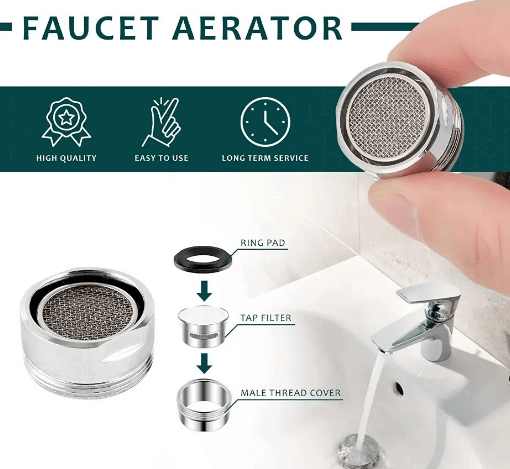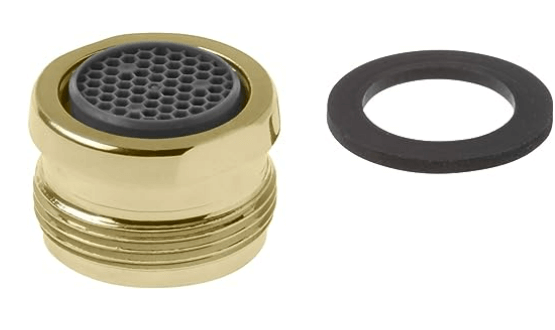How Does A Faucet Aerator Work To Save Water and Energy
Introduction
Have you ever wondered about the small device at the tip of your faucet that seems to magically reduce water usage without sacrificing water pressure? That ingenious device is called a faucet aerator, and it plays a crucial role in saving water and energy efficiency, and saving you money on your water bills. In this comprehensive guide, we will delve into the science behind how does a faucet aerator work, and their benefits, and why they are essential in modern plumbing systems.
What Is a Faucet Aerator?

A faucet aerator is a small attachment that fits onto the end of a faucet spout. Its primary function is to mix air with the flowing water, creating a stream of aerated water. This simple yet effective device has been a staple in plumbing for decades, serving both practical and environmental purposes.
How Does a Faucet Aerator Work?
To understand how does a faucet aerator works, it’s essential to grasp the concept of aeration and its impact on water flow and conservation:
- Aeration Process: A faucet aerator contains a fine mesh screen and a flow restrictor. As water flows through the faucet, it is forced through the mesh screen. This screen splits the water into numerous tiny streams, creating turbulence and mixing air with the water.
- Air Mixing: The introduction of air into the water stream causes it to become aerated. This means that the water is filled with tiny air bubbles, which gives it a cloudy or frothy appearance. These air bubbles create the sensation of increased water volume and effectively reduce the amount of water used while maintaining water pressure.
- Flow Restriction: The flow restrictor in the aerator limits the volume of water that can pass through at any given time. This control over water flow is essential for water conservation and energy efficiency.
Benefits of Using a Faucet Aerator
When we know how does a faucet aerators work , let’s take a look at the faucet aerators offer several benefits, making them an essential component in both residential and commercial plumbing systems:
- Water Conservation: One of the primary benefits of faucet aerators is their ability to conserve water. By mixing air with the water stream, they reduce water consumption without compromising the user experience. This can significantly contribute to water conservation efforts and reduce overall water bills.
- Energy Efficiency: Less water usage means less energy required to heat water. Using a faucet aerator can lead to substantial energy savings, particularly in households with hot water tanks or heaters.
- Cost Savings: Faucet aerators help reduce water consumption, which translates into lower water bills. Over time, the savings can be significant, making aerators a cost-effective investment.
- Environmental Impact: Conserving water is not just about saving money; it’s also about protecting the environment. Using less water reduces the strain on water sources and treatment facilities, helping to preserve freshwater ecosystems.
- Reduced Splashing: The aerated water stream is less likely to splash, making it easier to wash dishes, hands, or perform other tasks without making a mess.
- Preventing Water Waste: Faucet aerators help prevent excessive water waste by ensuring that the water flows efficiently and does not gush out unnecessarily.
- Customizable Flow: Many faucet aerators are designed with adjustable flow rates, allowing users to tailor the water flow to their specific needs, whether for washing dishes or filling a glass of water.
Types of Faucet Aerators
Faucet aerators come in various types, each designed to meet different needs and preferences:
- Standard Aerators: These are the most common faucet aerators, typically offering a flow rate of 2.2 gallons per minute (GPM). They are suitable for most general household tasks.
- Low-Flow Aerators: Low-flow aerators are designed to further reduce water consumption. They typically have flow rates ranging from 0.5 to 1.5 GPM, making them ideal for water-saving initiatives and eco-conscious individuals.
- Dual-Function Aerators: Dual-function aerators allow users to switch between spray and stream modes, providing greater versatility in everyday tasks.
- Swivel Aerators: Swivel aerators have a rotating spout, allowing users to direct the water flow precisely where they need it. This feature is especially handy in kitchens and bathrooms.
- Cache Aerators: Cache aerators are specific to certain faucet brands and models. They are not interchangeable and require a specialized tool for installation and removal.
How to Install a Faucet Aerator

After we know how does a faucet aerator work, so installing a faucet aerator is a straightforward process that requires minimal tools and expertise. Here’s a step-by-step guide on how to install one:
- Gather your tools and materials: You’ll need a pair of pliers and the faucet aerator you intend to install.
- Turn off the water supply: Locate the shut-off valves under the sink and turn them clockwise to close the water supply. This is essential to avoid any accidental water leakage during installation.
- Remove the existing aerator (if applicable): If your faucet already has an aerator, you’ll need to remove it. Use the pliers to grip the existing aerator and turn it counterclockwise to unscrew it from the faucet spout.
- Clean the faucet spout: Inspect the faucet spout to ensure it’s clean and free of debris. Use a brush or cloth to remove any residue or buildup.
- Install the new aerator: Screw the new faucet aerator onto the faucet spout by turning it clockwise. Hand-tighten it first and then use the pliers to secure it snugly. Be careful not to overtighten, as this could damage the aerator or the faucet spout.
- Turn on the water supply: Open the shut-off valves under the sink by turning them counterclockwise. Check for any leaks around the newly installed aerator. If you notice leaks, tighten the aerator a bit more until they stop.
- Test the aerator: Turn on the faucet and check the water flow. Ensure that the aerator is working correctly and that the water flows evenly and aerated.
- Make adjustments (if necessary): Some aerators have adjustable flow rates or spray patterns. If yours does, adjust it to your desired setting.
Maintenance and Cleaning

To ensure your faucet aerator continues to work efficiently and provide the benefits it offers, it’s essential to perform regular maintenance and cleaning:
- Remove and clean the aerator: Periodically remove the aerator from the faucet spout and clean it thoroughly. Soak it in vinegar to dissolve any mineral deposits or debris that may have accumulated over time.
- Check for damage: Inspect the aerator for any signs of damage, such as cracks or missing parts. If you notice any issues, consider replacing it to maintain optimal performance.
- Replace worn-out aerators: Over time, the mesh screen in the aerator may wear out or become clogged, affecting water flow. If cleaning doesn’t improve performance, replace the aerator with a new one.
Conclusion: Why Faucet Aerators Matter
Faucet aerators are unassuming yet indispensable devices that play a significant role in saving water and energy efficiency, and cost savings. So we should know how does a faucet aerator work, then use them help individuals, households, and communities reduce their environmental footprint while enjoying the same level of comfort and functionality in their daily water usage. In an era where sustainability is paramount, faucet aerators are a shining example of how small changes can make a big difference. So, the next time you turn on your faucet and marvel at the efficient flow of aerated water, remember that you’re contributing to a more sustainable and eco-friendly future.
 ARCORA FAUCETS
ARCORA FAUCETS
